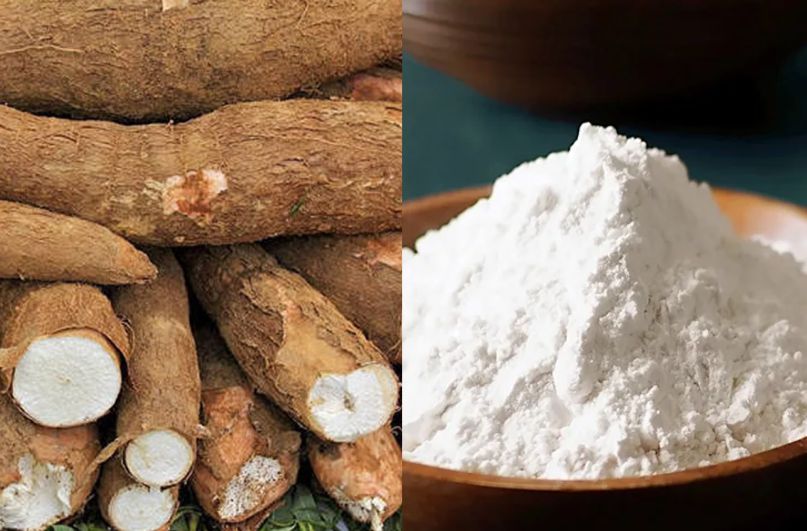Recently, there has been a growing interest in cassava tuber as a source of resistant starch. Resistant starch is a type of dietary fiber that resists digestion in the small intestine and instead ferments in the large intestine, where it promotes a range of health benefits.
As more consumers become aware of their dietary choices and their impacts on health, the focus on resistant starch as a functional food component has intensified.
Research indicates that resistant starch can contribute to improved digestive health, better blood sugar control, and enhanced satiety, potentially aiding in weight management.
This growing body of evidence puts cassava root on the frontline as an important source of resistant starch.
Cassava root can be prepared as cassava flour, it can also be made into fried cassava chips, or even fermented products, making it a favored ingredient in various dishes.
Throughout this blog, we will talk about cassava and its resistant starch.
Table of Contents
- What is Resistant Starch?
- Importance of Resistant Starch
- The Four Types of Resistant Starch
- How Resistant Starch Forms in Cassava
- Health Benefits of Cassava’s Resistant Starch
- Cooking and Preparation Methods to Maximize Resistant Starch
- Conclusion
What is Resistant Starch?
Resistant starch is a unique type of cassava starch with carbohydrates that escape digestion in the small intestine and are fermented in the large intestine, offering various health benefits.
This starch differs from regular starch, which is readily digestible. The structure of resistant starch allows it to maintain its integrity during the digestive process, providing an alternative energy source for beneficial gut bacteria.
Unlike conventional starch, which is broken down into glucose and absorbed into the bloodstream, resistant starch promotes a slower digestion process, leading to a more gradual release of glucose.
Importance of Resistant Starch
- Resistant starch acts as a prebiotic, feeding beneficial gut bacteria, which supports a healthy gut microbiome and improves digestion.
- It helps slow down the absorption of glucose, reducing blood sugar spikes and improving insulin sensitivity, making it beneficial for people with diabetes.
- Resistant starch increases feelings of fullness, reducing overall calorie intake, and can help with appetite control and weight loss.
- It is fermented in the colon, producing short-chain fatty acids like butyrate, which support colon health and may reduce the risk of colon cancer.
- By improving insulin sensitivity and supporting blood sugar regulation, resistant starch helps boost overall metabolism and reduce the risk of metabolic diseases.
Related: The Many Health Benefits of Cassava
The Four Types of Resistant Starch
While resistant starch is commonly found in foods like cassava, legumes, whole grains, and certain fruits, it exists in four distinct types, each with its own characteristics and health benefits.
Here are the four types of resistance starch:
Type 1: Resistant Starch in Whole Grains, Legumes, and Seeds
Type 1 resistant starch is found in foods with a tough cell structure, such as whole grains, legumes, and seeds.
This type of resistant starch is physically inaccessible to digestive enzymes due to the cellular walls that encase the starch granules.
When consumed, these starch granules pass through the small intestine largely intact and are not broken down for energy.
Instead, they make their way to the colon, where they are fermented by gut bacteria.
Sources:
- Whole grains (e.g., oats, barley, and quinoa)
- Legumes (e.g., beans, lentils, and chickpeas)
- Seeds (e.g., flaxseeds and chia seeds)
The health benefits of Type 1 resistant starch are numerous. By promoting a slower, more controlled digestion process, it helps prevent rapid blood sugar spikes and contributes to better blood glucose regulation.
Additionally, because Type 1 resistant starch is rich in fiber, it plays a vital role in promoting bowel regularity and enhancing overall gut health.
Type 2: Resistant Starch in Raw Potatoes and Green Bananas
Type 2 resistant starch is naturally found in raw, unripe potatoes and green bananas.
This form of resistant starch is “resistant” because its structure is more crystalline, making it harder for digestive enzymes to break it down.
In its raw form, Type 2 resistant starch is not readily digestible, but it can become more accessible after cooking or processing.
Sources:
- Raw potatoes (especially when they are unripe or not cooked)
- Green bananas or plantains before they ripen
- Some other starchy vegetables like corn and beans in their raw state
Interestingly, when Type 2 resistant starch is cooked and cooled as in the case of potatoes or green bananas, it undergoes a transformation that can increase its availability for fermentation in the colon.
This transition increases its resistant starch and also improves the health benefits, including improved gut health, better blood sugar control, and increased feelings of fullness.
Recommended: How to Make Cassava Starch at Home: Step by Step Guide
Type 3: Retrograded Starch Formed Through Cooking and Cooling
Type 3 resistant starch forms during the cooking and cooling process of starchy foods.
When foods like rice, pasta, or potatoes are cooked, their starches become gelatinized, making them easier to digest.
However, when these foods are subsequently cooled, some of the starch molecules undergo a process called retrogradation, which causes them to crystallize and become resistant to digestion again.
Sources:
- Cooked and cooled rice
- Cooked and cooled pasta
- Cooked and cooled potatoes
Retrograded starch is a source of resistant starch because it provides a higher level of fermentation in the colon, leading to the production of short-chain fatty acids like butyrate, which nourish the gut.
These short-chain fatty acids (SCFAs} are associated with improved gut health, reduced inflammation, and even enhanced fat-burning properties.
For those looking to maximize the benefits of Type 3 resistant starch, allowing cooked starchy foods to cool before consumption is an effective strategy.
Type 4: Chemically Modified Resistant Starch
Type 4 resistant starch is a form of resistant starch that has been chemically modified to enhance its resistance to digestion.
This type of starch is often used in processed foods to increase fiber content and provide beneficial effects on gut health.
Chemical processes like cross-linking are used to alter the starch’s structure, making it more resistant to enzymatic digestion.
Sources:
- Modified starch used in processed foods like baked goods, snack foods, and certain beverages
- Some food additives in low-calorie and “diet” products
Although Type 4 resistant starch is commonly found in processed foods, it’s important to note that the health benefits of this type of starch are still being studied.
While it offers a source of resistant starch for improving gut health and promoting satiety, it may not provide the same level of nutrients and antioxidants found in whole food sources like Type 1 or Type 2 starches.
Related: Best Tapioca Starch Substitutes
How Resistant Starch Forms in Cassava
Cassava as a source of resistant starch makes it and its derivatives into important dietary sources for promoting gut health and improving blood sugar control.
The formation of resistant starch in cassava depends on a variety of factors, including the variety of cassava, its ripeness, and cooking methods employed.
The Type of Cassava
All varieties of cassava contain resistant starch to some extent, but certain types may have higher levels depending on factors like the degree of maturation and how they are processed.
Different cultivars exhibit variable starch contents due to genetic differences and environmental conditions in which they are grown.
Ripeness and Maturity
Ripeness is another factor influencing resistant starch formation. As cassava matures, the starch granules undergo changes in structure and composition.
As cassava becomes more mature, the starch in the root transforms into a more resistant form, making it less digestible in the small intestine and more likely to reach the colon where it can be fermented by gut bacteria.
Cooking and Cooling
Cooking methods also influence the resistant starch levels in cassava. Raw cassava contains a higher concentration of resistant starch, but cooking can alter this.
When cassava is boiled, a portion of the resistant starch is converted to digestible starch.
However, cooling cooked cassava can lead to retrogradation, a process where some of the gelatinized starch reassociates and becomes resistant again.
This means that both raw and cooked forms of cassava can provide dietary resistant starch, but the preparation method can impact the amount available for consumption.
Recommended: Industry Trends of Tapioca Starch
Health Benefits of Cassava’s Resistant Starch
By adding cassava’s resistant starch into the diet, you can experience its benefits for digestive health, blood sugar regulation, and weight management.
- Digestive Health and Gut Flora: Cassava’s resistant starch promotes bowel regularity, reduces constipation, and encourages a healthy gut microbiota, aiding nutrient absorption and immune function. A balanced gut flora is essential for overall health.
- Blood Sugar Control: Resistant starch in cassava causes a gradual rise in blood glucose, benefiting individuals with insulin sensitivity or diabetes by helping to manage blood sugar levels.
- Weight Management: Resistant starch helps control calorie intake and increases fat oxidation, making cassava a valuable food for those aiming to maintain or achieve a healthy weight.
Related: Cassava Starch as a Thickener
Cooking and Preparation Methods to Maximize Resistant Starch
To maximize the resistant starch content in cassava, careful consideration of cooking methods is essential.
Among the common methods are boiling, steaming, and fermenting, each influencing the resistant starch levels distinctly.
Boiling
Boiling cassava is perhaps the most traditional method of preparation.
However, it is good to note that the cooking time can of course impact the resistant starch content.
A shorter boiling period may help retain a greater amount of resistant starch.
Once boiled, allowing cassava to cool before consumption is vital. Cooling the tuber facilitates the retrogradation process, wherein some of the digestible starch converts to resistant starch, enhancing its potential health benefits.
Steaming
Steaming is another effective cooking technique that preserves more nutrients and resistant starch compared to boiling.
Unlike boiling, which can leach beneficial compounds into the water, steaming cooks the tuber without water immersion, resulting in a denser, more nutrient-rich product.
This method also allows for the cooling stage afterward, further contributing to the resistant starch formation.
Fermenting
Fermenting cassava is an ancient method that not only enriches the tuber with probiotics but also increases resistant starch levels.
The fermentation process breaks down some of the digestible starches while promoting the production of resistant starch.
Incorporating fermented cassava into meals can maximize both the nutritional profile and health advantages.
Conclusion
Cassava root is a powerful source of resistant starch, a dietary fiber that supports digestive health and blood sugar regulation.
When consumed, its resistant starch ferments in the large intestine, producing short-chain fatty acids that promote gut microbiota health and digestion.
Additionally, cassava aids in weight management by increasing satiety and reducing calorie intake.
Its versatility makes it a delicious, nutritious addition to any diet, offering numerous health benefits without compromising flavor.
References:
- https://advancedhealth.com/wp-content/uploads/2024/02/78-Mar-Cassava-handout.pdf
- https://rmalab.com/wp-content/uploads/2019/09/8-Amazing-RS-Sources.pdf?myProvince=other
- https://bioscientistjournal.com/index.php/The_Bioscientist/article/view/33
I am Chimeremeze, a certified cassava farmer, processor and exporter. Also a writer and researcher with deep-rooted experience in processing, consuming, and utilizing locally produced cassava products, including cassava flour, tapioca flour and starch, garri, fufu, fried cassava balls, abacha, cassava chips, and more. Growing up in a community where cassava farming is a way of life, we have mastered its cultivation, processing, and sustainability, making it an essential part of our heritage.
My passion for the cassava plant and its countless benefits drives my research and writing, shedding light on its significance to West Africa and beyond. I also explore the impact of palm oil, another cornerstone of African agriculture, and how it continues to shape economies, diets, and traditions across the continent and the world.

